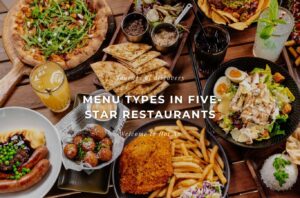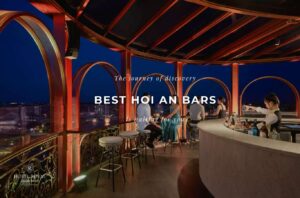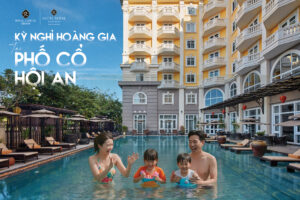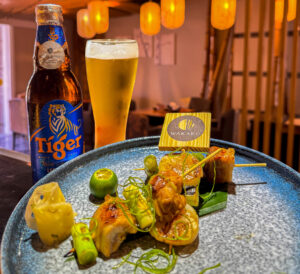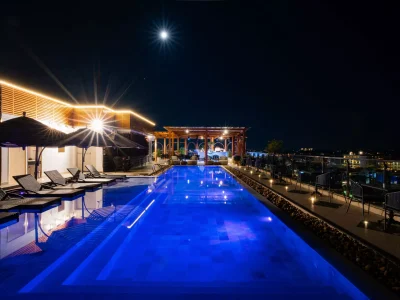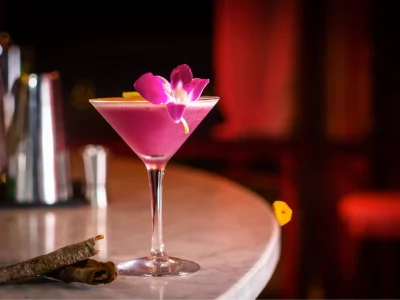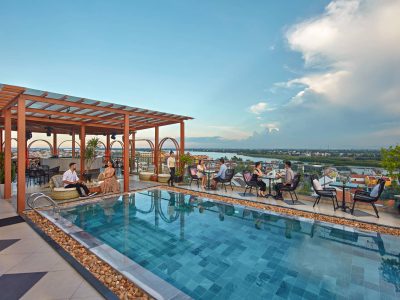In the fine dining industry, the menu plays a decisive role in shaping the guest experience at a 5-star restaurant. Each type of menu comes with its own presentation style, organizational principles, and service goals – reflecting the class and culinary identity of each establishment. This article by Hotel Royal Hoi An Gallery will introduce the most common and distinctive 5-star restaurant menu types, giving you a comprehensive and in-depth view of menu standards in the high-end dining industry.
Table of Contents
ToggleCommon menu styles used in five-star restaurants
À La Carte Menu
The à la carte menu is a common service style in 5-star restaurants, allowing guests to choose individual dishes instead of a set menu. Previously, this form was popular in European restaurants with extensive menus of up to around 120 dishes. However, today many Asian restaurants have also adopted this service style, though in a more streamlined format with only 25 to 40 dishes or fewer.
A notable feature of this menu type is that each dish has its own name, description, and price, helping guests flexibly choose according to their preferences and tastes. These menus are usually organized clearly, starting with appetizers such as soups and salads, followed by main courses like steak, sushi, or seafood, and ending with desserts like cakes or fresh fruits.
The biggest advantage of the à la carte menu is its high level of personalization, suitable for the diverse needs of diners. Additionally, choosing individual dishes also helps in better controlling portion sizes and managing costs.

Buffet Menu
The buffet menu (also known as self-service) is a common serving style in large-scale hotels and restaurants. With this format, guests can freely choose and enjoy a variety of dishes at a fixed price.
Buffets originated in Europe and quickly became popular worldwide, especially suited for parties, conferences, or crowded service settings. Dishes are displayed on a buffet line for guests to serve themselves freely, with no limit on the number of servings or quantity. As a result, the dining experience becomes more flexible, free, and exploratory.
The advantage of this menu type is that it allows guests to actively choose dishes according to their preferences and enjoy a wide variety of items in a single meal.

Meal-Based Menu
The meal-based menu is a type of arrangement where dishes are pre-designed for specific meals such as breakfast, lunch, or dinner. Each meal usually includes fixed dishes, built based on nutritional needs, portions, and eating habits of different customer groups. This type of menu is common in restaurants that serve industrial meals, schools, hospitals, or hotels offering all-inclusive dining services.
The advantage of the meal-based menu is effective control over nutrition, time-saving service, and easier cost management. However, this format is less flexible as guests are not able to choose dishes based on personal preferences.

Pre-ordered Menu
The pre-ordered menu at 5-star restaurants is an ideal choice for upscale events such as weddings, conferences, or private parties. Typically, this menu includes 2 to 7 courses, specially designed by professional chefs using premium ingredients such as abalone, lobster, salmon, or wagyu beef.
Each dish focuses not only on flavor but also on refined presentation, suited to the luxurious setting of a 5-star restaurant. In addition, attentive and professional service contributes to a complete and high-class dining experience.

Rotating Menu at Resorts
The rotating menu at resorts is a type of menu that changes on a daily, weekly, or seasonal basis to offer variety and avoid monotony for guests staying over an extended period. This type of menu is commonly applied at resorts offering full-board or half-board meal services, especially in high-end destinations serving long-stay travelers.
Each day, the kitchen prepares a different meal list for breakfast, lunch, and dinner, balancing nutrition, local flavors, and seasonal factors. The advantage of a rotating menu is that it gives guests a rich culinary experience and a fresh feel each day without having to choose individual dishes. At the same time, this model also helps the resort optimize preparation processes and manage ingredients more effectively.
Banquet menu
The banquet menu is a curated list of dishes specially prepared for large-scale events such as weddings, corporate parties, or formal gatherings. Depending on the event style, the menu can be served as seated meals, buffets, or cocktail-style receptions. Each format follows a different course arrangement but generally adheres to the sequence of appetizer, main course, side dish, and dessert.
In addition to ensuring flavor, the banquet menu must be carefully calculated in terms of cost, presentation, and serving time. Furthermore, a clearly designed menu, professionally printed and featuring elegantly presented dishes, will elevate the guest experience and contribute significantly to the overall success of the event.

Wine menu
The wine menu is an essential element of upscale events, particularly weddings, corporate parties, or occasions involving international guests. This is a selection of wines chosen to accompany the entire meal, typically including white wine, red wine, spirits, and sometimes cocktails or champagne.
Choosing the right wine involves more than budget, it also requires a refined understanding of food pairing. For instance, white wine often complements seafood or white meat, while red wine pairs better with red meat, grilled dishes, or more robust flavors. In formal settings, the wine menu may also include tasting notes or food pairing suggestions to create a complete and elegant experience for guests.
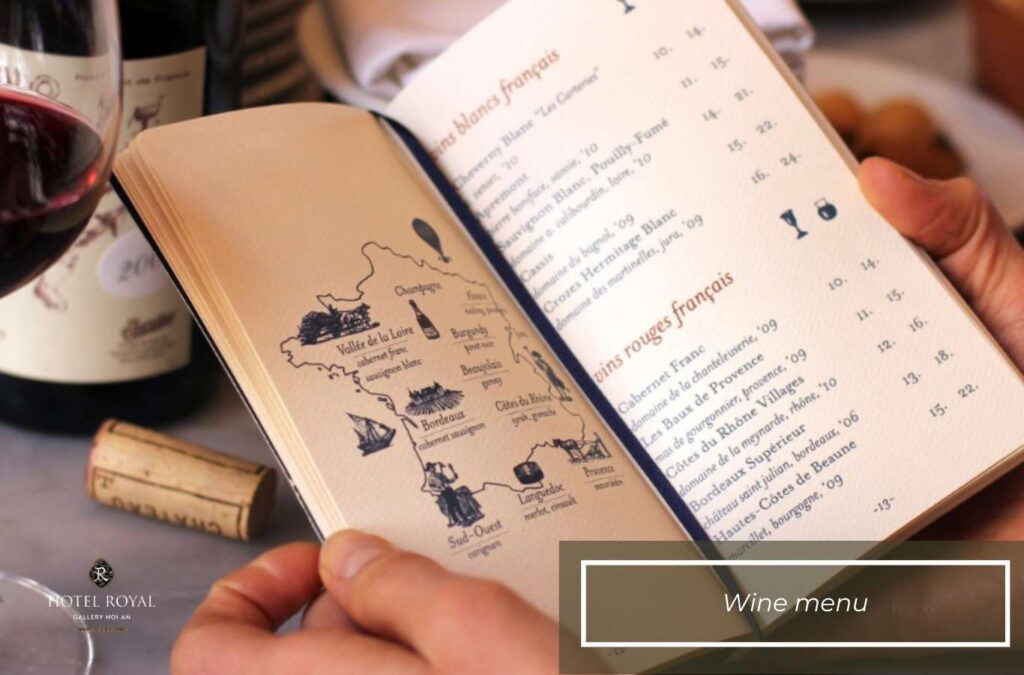
Room service menu
The room service menu is a popular amenity offered by hotels, resorts, and luxury accommodations to provide convenience and privacy for guests. Instead of visiting the restaurant, guests can comfortably select and enjoy their favorite dishes in-room at any time of the day. Room service menus often feature a wide variety, from light snacks and main courses to desserts and beverages like tea, coffee, juices, and alcoholic drinks. Some establishments even offer local specialties or personalized menus upon request.
Room service menus are typically presented clearly with illustrated images, listed prices, and specific service hours, enabling guests to easily place orders via phone or the hotel’s internal app. Thanks to its convenience, thoughtful service, and growing quality, this offering continues to gain popularity among high-end hospitality venues.

Tasting menu
The tasting menu is a culinary experience composed of multiple small, thoughtfully arranged dishes that guide diners through an emotional and flavorful journey. Each dish in the tasting menu is crafted with sophistication, presented beautifully, and often showcases high levels of creativity. It reflects the chef’s personal signature and the restaurant’s culinary identity. The number of courses typically ranges from 5 to over 10, starting with a light appetizer and progressing through main and side dishes, finishing with an elegant dessert.
More than just a meal, a tasting menu represents a form of culinary art, where chefs tell stories through ingredients, techniques, and inspiration. It’s the perfect choice for those who appreciate discovering new cuisines, value detail, and want to fully experience the chef’s talent and personality. Some restaurants also offer wine pairing with the tasting menu, enhancing the flavors and creating a refined dining experience from beginning to end.

International Cuisine Menus
Today, international cuisine menus are widely embraced in restaurants and events thanks to their ability to deliver diverse culinary experiences. Let’s explore some popular types of these menus below!
European-style menu
The European-style menu is a general term referring to culinary traditions originating from various European countries, including renowned cuisines from France, Italy, Spain, Germany, Greece, and the UK. Each country has its own preparation techniques and distinctive flavors, yet European cuisine shares common traits such as refined ingredient selection, balance between meat, vegetables, and starches, and beautiful, well-ordered plating. For example:
- Italy offers antipasto (cold cuts and cheese), pasta, risotto, oven-baked pizza, and desserts like tiramisu or panna cotta.
- Spain is known for tapas (small shared plates), saffron-infused paella with seafood or meat, chorizo sausages, and dishes inspired by Mediterranean flavors.
- Germany brings grilled sausages (bratwurst), beer-braised pork, dark rye bread, sauerkraut, and baked apple desserts.
Each dish is often paired with suitable wines to highlight its signature flavor, resulting in a comprehensive and sophisticated dining experience.
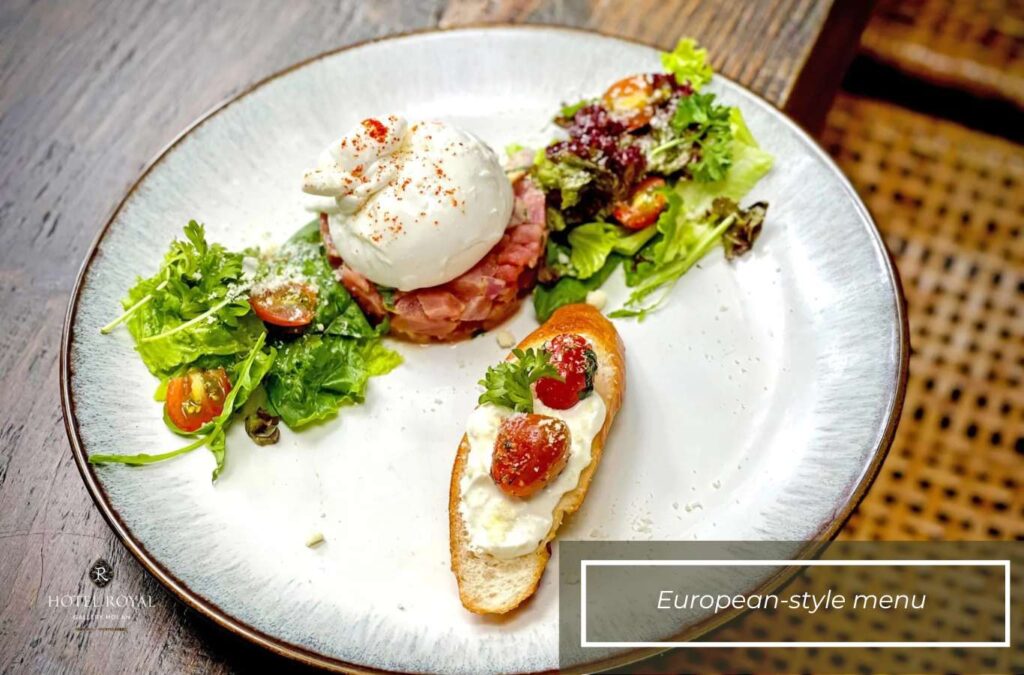
Asian-style menu
The Asian-style menu features signature dishes from Asian culinary cultures such as Chinese, Japanese, Korean, Thai, and Vietnamese. Unlike the European format where dishes are served in a sequence, Asian menus typically present all dishes simultaneously, encouraging warmth and sharing at the table.
Typical dishes combine salty, sweet, sour, and spicy notes, usually accompanied by steamed rice, noodles, or vermicelli. A common Asian menu might include chicken and mushroom soup, mango shrimp salad, steamed chicken with lime leaves, soy-sauce-steamed fish, stir-fried beef with bok choy, and desserts like sweet soups or fresh fruit.
In addition to diverse ingredients, Asian menus stand out for their cooking techniques – steaming, boiling, high-heat stir-frying, or deep-frying, preserving natural flavors. This menu style is well-suited for weddings, company banquets, family gatherings, or events hosting large groups.

Fusion menu – Cross-cultural creations
The Fusion menu is a creative blend of different culinary styles, often merging Eastern and Western traditions to create unique and innovative yet harmonious dishes. It’s not just about combining ingredients, but also blending cooking techniques, presentation styles, and cultural influences.
Examples include American-style sushi rolls with cheese and wasabi mayo, Japanese-inspired seafood pizza with dried seaweed, or black pepper beef served with mashed potatoes. The goal of the fusion menu is to deliver a novel and surprising experience while maintaining familiar, comforting flavors.
Fusion menus break free from traditional culinary rules, allowing chefs full creative freedom to express their personal style. As a result, each fusion restaurant has a distinct character – some leaning more Asian, others more Western, depending on the concept behind the menu.
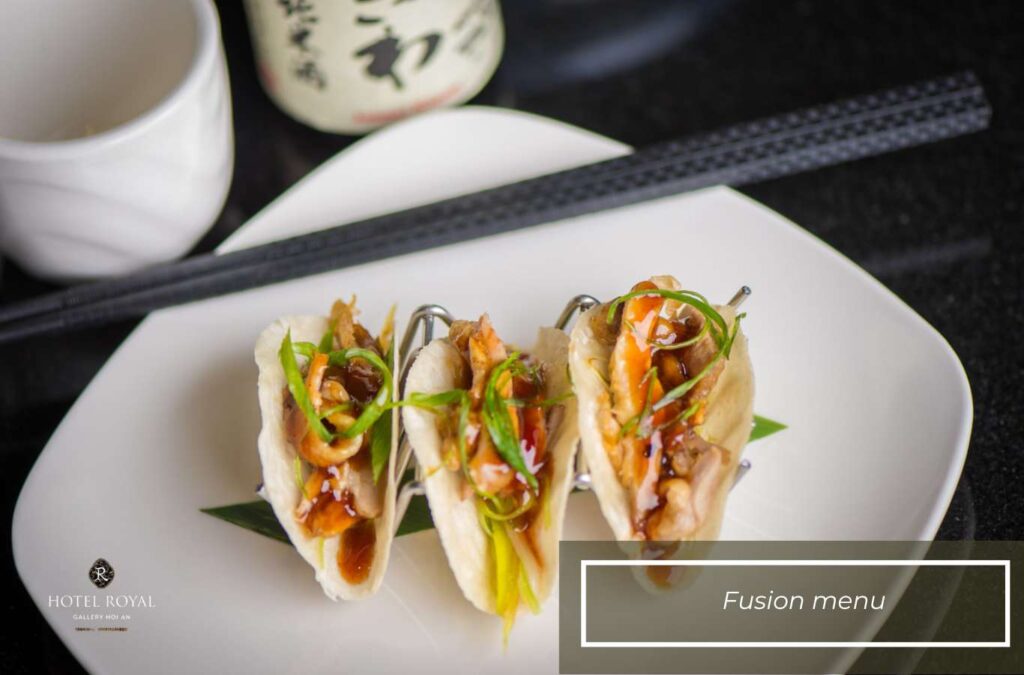
Principles for Designing a 5-Star Restaurant Menu
Designing a menu for a 5-star restaurant is a process that requires the integration of aesthetic sense, culinary knowledge and deep understanding of customer experience. Below are the essential principles to follow when creating a 5-star standard menu.

- Reflect the restaurant’s identity: The menu should embody the main culinary style (French, Italian, Japanese, fusion…) and the unique signature of the chef or brand.
- Focus on ingredient quality: Prioritize the use of premium, fresh, and traceable ingredients to ensure flavor and safety.
- Balance dish structure: Distribute courses logically among appetizers, main courses, and desserts; ensure harmony in color, texture, and nutrition.
- Diverse yet streamlined: The menu should offer sufficient variety for selection but avoid being overly extensive, which can confuse guests and compromise consistency.
- Seasonal rotation: Change the menu according to the seasons to take advantage of in-season ingredients and offer freshness to returning guests.
- Accommodate special dietary needs: Provide options for vegetarians, gluten-free diners, children’s menus, or special nutritional requests.
- Elegant, clear language: The menu should be presented professionally, preferably bilingual (commonly Vietnamese – English), with clear descriptions that remain sophisticated.
We hope this article has given you deeper insight into the types of menus found in 5-star restaurants and their role in crafting a premium dining experience. Choosing the right type of menu suited to service style, customer profile, and the restaurant’s ambiance helps elevate service quality and create a professional impression. This forms a crucial foundation for those running or planning to develop a high-end culinary model.
And if you’re looking for a destination to bring these culinary values to life, Hotel Royal Hoi An Gallery is the ideal place. Located along the poetic Thu Bon River and just a few minutes’ walk from Hoi An Ancient Town, Hotel Royal Hoi An Gallery is an internationally rated 5-star boutique hotel. It stands out with an architectural blend of Indochine charm and elegant Japanese spirit, offering a luxurious space rich in local identity.
Faifo Café and Wakaku, the hotel’s two signature restaurants, are highlights in Hoi An’s culinary scene:
- Faifo Café serves Asian – European menus, breakfast buffets, and Central Vietnamese specialties prepared with refinement.
- Wakaku – the first Japanese restaurant in Hoi An, offers a unique Omakase experience featuring fresh ingredients and top-tier presentation artistry.
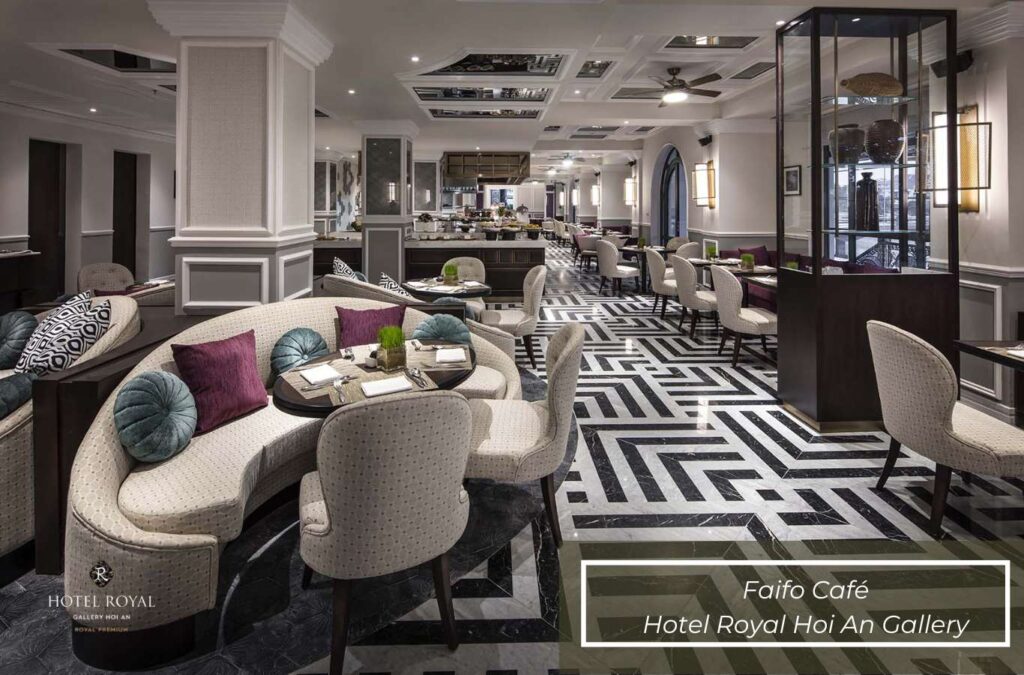

At this destination, the menu not only reflects culinary sophistication but also demonstrates a commitment to customer experience, from ingredient quality to service style and a royally inspired ambiance. Let Hotel Royal Hoi An Gallery lead you into a world of culinary excellence and living heritage.
Read more:



